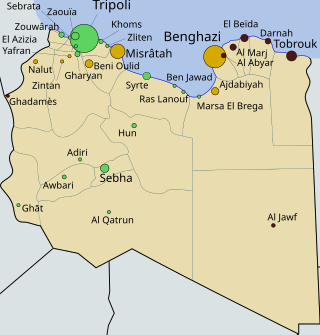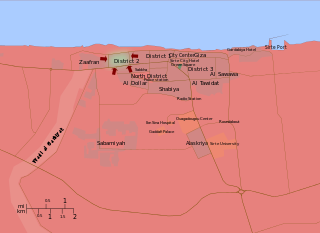
Saif al-Islam Muammar al-Gaddafi is a Libyan political figure. He is the second son of the late Libyan leader Muammar Gaddafi and his second wife Safia Farkash. He was a part of his father's inner circle, performing public relations and diplomatic roles on his behalf. He publicly turned down his father's offer of the country's second highest post and held no official government position. According to United States Department of State officials in Tripoli, during his father's reign, he was the second most widely recognized person in Libya, being at times the de facto prime minister, and was mentioned as a possible successor, though he rejected this. An arrest warrant was issued for him on 27 June 2011 by the International Criminal Court (ICC) for charges of crimes against humanity against the Libyan people, for killing and persecuting civilians, under Articles 7(1)(a) and 7(1)(h) of the Rome statute. He denied the charges.
Zintan is a city in northwestern Libya, situated roughly 136 kilometres (85 mi) southwest of Tripoli, in the area. The city and its surrounding area has a population of 16,024.

The Libyan civil war or the 2011 Libyan revolution, also known as the First Libyan Civil War was an armed conflict in 2011 in the North African country of Libya that was fought between forces loyal to Colonel Muammar Gaddafi and rebel groups that were seeking to oust his government. The war was preceded by protests in Zawiya on 8 August 2009 and finally ignited by protests in Benghazi beginning on Tuesday, 15 February 2011, which led to clashes with security forces who fired on the crowd. The protests escalated into a rebellion that spread across the country, with the forces opposing Gaddafi establishing an interim governing body, the National Transitional Council.

The battle of Misrata, also known as the siege of Misrata, was a battle of the 2011 Libyan Civil War for the control of Misrata. It was fought between troops loyal to the government of Muammar Gaddafi, and anti-Gaddafi rebels who held Misrata, the third largest city in Libya. Following the initial stages of the uprising, the Libyan government took back most towns in the west of the country, leaving Misrata the only major city under rebel control in Tripolitania. The city soon became the site of one of the war's major battles and the suffering of its citizens gained worldwide attention.
Khamis Gaddafi was the seventh and youngest son of former Libyan leader Muammar Gaddafi, and the military commander in charge of the Khamis Brigade of the Libyan Army. He was part of his father's inner circle. During the Libyan Civil War in 2011, he was a major target for opposition forces trying to overthrow his father.
The Battle of Zintan, was a significant conflict that took place during the 2011 Libyan Civil War. Zintan, a town in northwestern Libya, was a stronghold of anti-Gaddafi forces. The battle primarily involved rebel fighters from Zintan and government loyalist forces. The rebels managed to capture the town and defend it against repeated attacks by Gaddafi's forces. The battle highlighted the determination of the rebels to resist Gaddafi's rule. Ultimately, the rebels were successful in maintaining control of Zintan, which played a role in the broader effort to overthrow Gaddafi's regime.
The Nafusa Mountains campaign was a series of battles in the Libyan Civil War, fought between loyalist pro-Gaddafi forces and rebel anti-Gaddafi forces in the Nafusa Mountains and, at a later period, in the surrounding plains of western Libya. The mountain range is of strategic importance due to its close proximity to the capital of Tripoli. Along with the city of Misrata, the Nafusa Mountains region was one of the major rebel strongholds in Tripolitania.
The Battle of Wazzin was a conflict during the Libyan Civil War for the Libyan-Tunisian border town of Wazzin. Rebel forces made an initial victory, but it was short-lived as Gaddafi's men re-occupied the town, only to lose it again to the rebels.

The 2011 Sabha clashes were a series of clashes between forces loyal to Libyan leader Muammar Gaddafi and rebel anti-Gaddafi forces for control of the desert oasis city of Sabha and a part of the Libyan Civil War which took place during June 2011.

The Libyan Civil War began on 15 February 2011 as a chain of civil protests and later evolved into a widespread uprising against the regime of Muammar Gaddafi. On 25 February, most of eastern Libya was reported to be under the control of protesters and rebel forces. Gaddafi remained in control of the cities of Tripoli, Sirte and Sabha. By 15 March, however, Gaddafi's forces had retaken more than half a dozen lost cities. Except for most of Cyrenaica and a few Tripolitania cities the majority of cities had returned to Gaddafi government control.

The timeline of the Libyan civil war begins on 15 February 2011 and ends on 20 October 2011. The conflict began with a series of peaceful protests, similar to others of the Arab Spring, later becoming a full-scale civil war between the forces loyal to Muammar Gaddafi's government and the anti-Gaddafi forces. The conflict can roughly be divided into two periods before and after external military intervention authorized by United Nations Security Council Resolution 1973.

The Tripoli Revolutionaries Brigade or Free Tripoli Guardian was a unit of the National Liberation Army of Libya created during the Libyan Civil War that merged into the Tripoli Protection Force. Originally formed in April 2011 in the opposition stronghold of Benghazi, it later relocated to the Nafusa Mountains, then the closest frontline to Tripoli, before advancing into the city itself in August.
The First Battle of Zawiya or Zawia was a battle during the Libyan Civil War between army units and militiamen loyal to Muammar Gaddafi and anti-Gaddafi forces for control of the city of Zawia.

The Libyan Civil War began on 15 February 2011 as a civil protest and later evolved into a widespread uprising. However, by 19 March, Libyan forces under Colonel Muammar Gaddafi were on the brink of a decisive victory over rebels in Libya's east. That day, leading NATO members acted on United Nations Security Council Resolution 1973 which authorized member states "to take all necessary measures... to protect civilians and civilian populated areas under threat of attack in the Libyan Arab Jamahiriya, including Benghazi, while excluding an occupation force".

The Battle of Sirte was the final and most decisive battle of the First Libyan Civil War, beginning when the National Liberation Army attacked the last remnants of the Libyan army still loyal to Muammar Gaddafi in his hometown and designated capital of Sirte, on the Gulf of Sidra. As of September 2011, Sirte and Bani Walid were the last strongholds of Gaddafi loyalists and the National Transitional Council hoped that the fall of Sirte would bring the war to an end. The battle and its aftermath marked the final collapse of the four-decade Gaddafi regime. Both Gaddafi and his son, Mutassim, were wounded and captured, then tortured and killed in custody less than an hour later. The month-long battle left Sirte almost completely in ruins, with many buildings damaged or totally destroyed.

The 2011 Libyan Civil War began on 17 February 2011 as a civil protest and later evolved into a widespread uprising. After a military intervention led by France, the United Kingdom, and the United States on 19 March turned the tide of the conflict at the Second Battle of Benghazi, anti-Gaddafi forces regrouped and established control over Misrata and most of the Nafusa Mountains in Tripolitania and much of the eastern region of Cyrenaica. In mid-May, they finally broke an extended siege of Misrata.

Major General Osama al-Juwaili is a Libyan military officer who served as Minister of Defence in the government of Abdurrahim El-Keib, Libya's interim Prime Minister. Since the formation of the Government of National Accord (GNA) in 2015, al-Juwaili served it as a senior commander, since 2017 being the commander of the Western Military Zone. On 6 April 2019 he became the commander of the joint operations room, created by Prime Minister Fayez al-Sarraj to coordinate military operations since the start of the 2019 Western Libya offensive.
The 2012 Bani Walid uprising was an event which started on 23 January 2012 due to an incident in the city of Bani Walid in which the "May 28 Brigade" militia wished to arrest local men in unclear circumstances. The May 28 Brigade and their compound were then attacked by local fighters who then took control of the town. The incident, the combatants, and the motives of the two main belligerents — the May 28 Brigade and Brigade 93 — remain uncertain and contentious. The conflict was originally reported to be an attack by Gaddafi loyalists by local NTC officials. However, tribal leaders and residents have denied any affiliation with Gaddafi's remnants, stating their goal was the establishment of their own council in the city. Similarly Britain's Foreign Office has dismissed claims of this incident representing a pro-Gaddafi attack against the NTC, stating that this was a dispute between tribal leaders of the Warfalla tribe and the NTC.

Following the end of the First Libyan Civil War, which overthrew Muammar Gaddafi, there was violence involving various militias and the new state security forces. This violence has escalated into the Second Libyan Civil War (2014–2020).

Gaddafi loyalism, in a wider political and social sense also known as the Green resistance, consists of sympathetic sentiment towards the overthrown government of Muammar Gaddafi, who was killed in October 2011, and his Third International Theory. Despite Muammar Gaddafi's death, his legacy and Jamahiriya ideology still maintains a popular appeal both inside and outside Libya into the present day. Regardless, the Western sentiment has largely been that this continued support may contribute to some of the ongoing violence in Libya.










